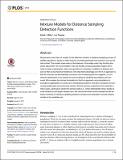Files in this item
Mixture models for distance sampling detection functions
Item metadata
| dc.contributor.author | Miller, David Lawrence | |
| dc.contributor.author | Thomas, Len | |
| dc.date.accessioned | 2015-04-09T16:01:02Z | |
| dc.date.available | 2015-04-09T16:01:02Z | |
| dc.date.issued | 2015-03-20 | |
| dc.identifier.citation | Miller , D L & Thomas , L 2015 , ' Mixture models for distance sampling detection functions ' , PLoS One , vol. 10 , no. 3 , e0118726 . https://doi.org/10.1371/JOURNAL.PONE.0118726 | en |
| dc.identifier.issn | 1932-6203 | |
| dc.identifier.other | PURE: 26520107 | |
| dc.identifier.other | PURE UUID: c43efce8-6960-4577-8f6b-0356efde3f9f | |
| dc.identifier.other | Scopus: 84925878970 | |
| dc.identifier.other | ORCID: /0000-0002-7436-067X/work/29591668 | |
| dc.identifier.other | WOS: 000352084200036 | |
| dc.identifier.uri | https://hdl.handle.net/10023/6463 | |
| dc.description | Funding: EPSRC DTG | en |
| dc.description.abstract | We present a new class of models for the detection function in distance sampling surveys of wildlife populations, based on finite mixtures of simple parametric key functions such as the half-normal. The models share many of the features of the widely-used “key function plus series adjustment” (K+A) formulation: they are flexible, produce plausible shapes with a small number of parameters, allow incorporation of covariates in addition to distance and can be fitted using maximum likelihood. One important advantage over the K+A approach is that the mixtures are automatically monotonic non-increasing and non-negative, so constrained optimization is not required to ensure distance sampling assumptions are honoured. We compare the mixture formulation to the K+A approach using simulations to evaluate its applicability in a wide set of challenging situations. We also re-analyze four previously problematic real-world case studies. We find mixtures outperform K+A methods in many cases, particularly spiked line transect data (i.e., where detectability drops rapidly at small distances) and larger sample sizes. We recommend that current standard model selection methods for distance sampling detection functions are extended to include mixture models in the candidate set. | |
| dc.format.extent | 19 | |
| dc.language.iso | eng | |
| dc.relation.ispartof | PLoS One | en |
| dc.rights | Copyright: © 2015 Miller, Thomas. This is an open access article distributed under the terms of the Creative Commons Attribution License, which permits unrestricted use, distribution, and reproduction in any medium, provided the original author and source are credited. | en |
| dc.subject | QA Mathematics | en |
| dc.subject | QH301 Biology | en |
| dc.subject | DAS | en |
| dc.subject.lcc | QA | en |
| dc.subject.lcc | QH301 | en |
| dc.title | Mixture models for distance sampling detection functions | en |
| dc.type | Journal article | en |
| dc.description.version | Publisher PDF | en |
| dc.contributor.institution | University of St Andrews. School of Mathematics and Statistics | en |
| dc.contributor.institution | University of St Andrews. Statistics | en |
| dc.contributor.institution | University of St Andrews. Centre for Research into Ecological & Environmental Modelling | en |
| dc.contributor.institution | University of St Andrews. Marine Alliance for Science & Technology Scotland | en |
| dc.identifier.doi | https://doi.org/10.1371/JOURNAL.PONE.0118726 | |
| dc.description.status | Peer reviewed | en |
This item appears in the following Collection(s)
Items in the St Andrews Research Repository are protected by copyright, with all rights reserved, unless otherwise indicated.

